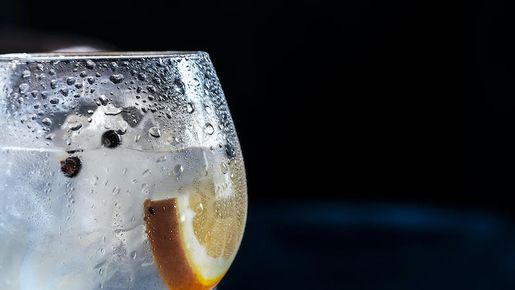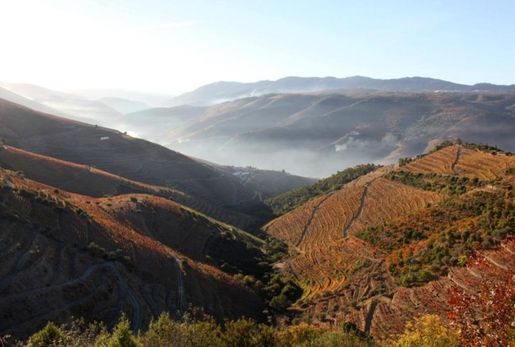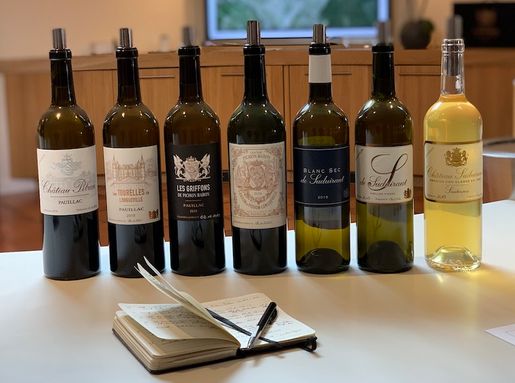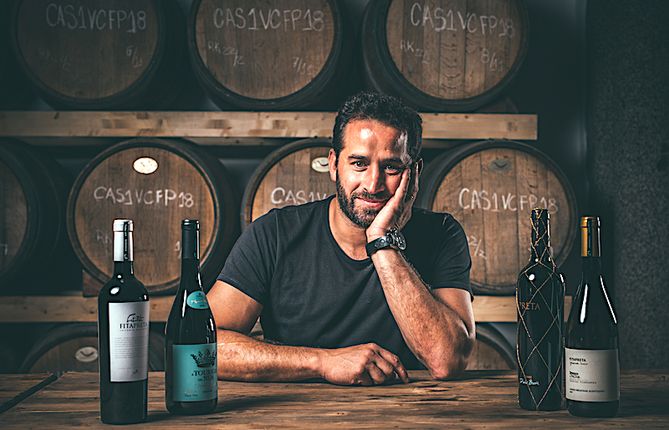
Wine - a retrospective on its role, alcohol trends, diversity and culture. By António Macanita.
The first day of the Year it is an honour for Vinbanken to invite a special and a important voice to share thoughts with wine-loving readers.
For the much looked forward year 2021, what will also be a start of the Worlds great recovery year, Vinbanken is very honoured to present António Macanita, winemaker on the remote islands of the Azores, Portugal (amongst other origins).
It is my belief that the Wineworld is lucky to have such a dedicated person as Macanita around. Antónios burning ambition sees to that we, wine-lovers, are able to get to know some of the wines of grape varieties we never knew existed. And would it not be for António Macanita these wines would be lost for the World.
Wine a retrospective studie for 2021 - BY ANTÓNIO MACANITA
António Macanita, Azores Portugal
At first it felt strange for me, or even out of tone, to be speaking of such a frivolous theme like wine at a time like this. We are in the middle of this Pandemic, and bigger problems are in hands. These involving human tragedy and such uncertainty about our future.
But the more I thought about it, the more it felt right to talk about wine. Because talking about wine is talking about the story of our civilization. Wine has always been here, to feed us, to warm us, to witness rises and fall of empires, its beeing part of the beginning of all the religions and has taken us through some of the worst plagues like the “black death”. At that time it was known as aqua vita (water of life). A trustable source of hydration in times of uncertain quality of water.
So, wine has always been here. But why is this. What makes wine so special to have become, together with bread, symbols of the western civilization? Understanding this, is getting closer to understanding the definition of a great wine. So, buckle up for this journey with me!
In the beginning wine is food
It was lost in time the inventor of wine, the Man that one day decided to store for later, the grapes he had collected. The grapes, like all the other fruits, fermented spontaneously, but for some reason, the fermented juice still tasted acceptable and more important it was somehow stable, and lasted for longer, than the other juices.
This fact alone allowed the collector, to increase its autonomy and assured a trustable source of energy and hydration for needed times when food was scarce. The story of bread is somewhat similar. Cereals can also be harvested, stored, and used for later. The oldest evidence of wine is from around 8 000 years ago. But knowing that pottery has been around for 25 000 years and grapes longer, it is very likely that Man has been drinking wine for longer.
But what makes wines so special that it can preserve itself? Grapes combine two main characteristics that make them different from all the other fruits: high sugar concentration with a low pH between, 3 and 4.
The high sugar content translates after fermentation into a natural higher alcohol, that is a formidable antiseptic and preserving capacity as we know. The low pH protects the wine by not allowing any harmful pathogenic microorganism to develop, avoiding spoilage, and way assuring that even in the worst conditions wine wouldn’t poison you, it would just taste bad.
The diversity of grape varieties
The Man collector-hunter, started the gradual transformation into a Man-farmer around 10 000 years ago. Farming the needs for the daily life meant that people settled down in one place. The new era allowed the population to grow, to conquer new territories, to discover new fertile lands always carrying the precious seeds.
This movement of populations, normally accompanied by battles, wars and after co-living fusions between tribes and crossing of populations took place throughout thousands of years.
The traces from these ancient times can be reflected in our genetics. And when it comes to vines also in the richness of the different grape varieties that can be found in every wine producing country where many of them now can count to over 6 000 different grape varieties.
The more alcohol the better is a 2 500 years journey, not Parker’s fault
Robert Parker has been attributed the merit and sin of creating a taste for high alcoholic wines. But history seems to tell another version of the story where Man seemed to have tried to reach higher alcohol strength for much longer times than Parker.
The fact is that some wines lasted for days, other for weeks, or even months and some for ages. But why was this and what was the difference?
This was crucial for Man to understand as wine that lasted longer could be transported further away. Wine could thus become a more valuable merchandise. Therefore, Man had to perfect his craft. Winemakers learned to understand the trial/error strategy, that wine preserved better when alcohol was higher and also preserved better when the pH was lower.
Preservatives for wine
So, by 300 BC, although there where no pH meters at the time, Greeks according to Theophrastus, where already lowering pH of wines by adding among other things, Gypsum plaster (CaSO4) to wine. This improved the stability in the wine.
The same doing is later reported by Columella, a roman writer that lived 70 AD. This old technique is still authorized in some fortified wine regions, but it has been replaced by Tartaric Acid. The acid of grapes.
Columella explains further that to adjust the sugar content, and consequently the increase future alcohol of the must, a dose of defrutum would be added. The defrutum was no more than concentrated must resulting from boiled must to 1/3 of its volume and then added back. Still today in years of bad weather when sugar might not reach the minimum, some wine regions, still are authorized to use concentrated must. Several other authors refer to similar techniques and others, like adding salt, spices, and aromatic herbs to the must.
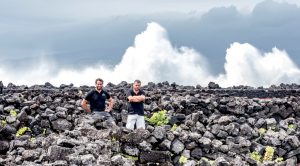 Vingårdar med det dånande havet i bakgrunden, Pico Azorerna.
Vingårdar med det dånande havet i bakgrunden, Pico Azorerna.
Wine for drinking and a wine for celebrating
By the end of the 13th century, it becomes clearer that there are two categories of wine that always coexisted: the wine for drinking and a wine for celebrating. The first categories are somehow still food, lower in alcohol, normally red and simple. The second is higher in alcohol, normally golden, luscious and concentrated.
One of the references of luxury wine at this time was Crete (Candia). But when Crete was conquered, the islands of Madeira, Azores and Canary followed in the tradition of those “golden wines”. The Volcanic islands seemed to have the talent of producing wines both high alcohol and high acid and that gave them a formidable ageing potential. This was an advantage that made the wines conquer the Americas. Remember that almost the totality of the Americans where drinking wine at the end of the 18th century. Not to be forgotten is the issue of taxes on wines as one of the reasons behind the American Revolution.
And then destillation
It is only in the mid 17th century, that the use of distillation comes into play for wine and provides a new more effective way to increase the alcohol strength in wines, assuring its ageing potential even further. Port, Madeira, and Sherry are some of those examples of the success in fortification that remained till today. They are also fine examples of wines that can last forever. But what most people don’t know is that, with rare exceptions, all regions where still by the 19th century adding some form of spirit, sugar, or other to increase alcohol in wine.
Bordeaux in retrospect to consider
One of the most unbelievable examples is Bordeaux. Even as late as in the beginning of the 19th century according to Andre Julien, wine specialist from Paris and known as the precursor to the 1855 Bordeaux Classification, explains that Bordeaux wine would go through a process called “travail à l'anglaise”. This included adding per barrel: 13 to 18 pots of red wine from Alicante or Benicarlo from Spain, 1 pot of white must still unfermented, and 1 bottle of spirit.
This style of wine would achieve a better price then the unprepared version. Further south in the warm Alentejo region of Portugal must can today naturally achieve 14 to 15% of potential alcohol. Climate change would be one reason. But in 1860’s the must would barely reach 11,5 and the rest of the alcohol content would have been added in the form of spirit. Also, if you think of champagne, still today the process includes adding 24 g/L of sugar for a second fermentation increasing alcohol by 1,5 %.
One example is Moet & Hennessy who is in a collaboration with a wine producer and spirits company, and, although today no more spirits are added in Champagne.
By today standards some of these methods, if not part of the identity, culture and rules of the region, would be considered counterfeiting.
So, in the past wines had much lower natural alcohol, and most regions had a hard time reaching more than 10% alcohol. Today it is different as regions easily can reach 15% of alcohol. But what happened between these 2 numbers of alcohol content? You are thinking climate change, and for sure it is impacting, but there are other reasons.
20th Century – the big revolution in the vineyards
Contrary to common believe, the general increase of alcohol strength in wines did not come from any type of trickery in the winery. It is quite the opposite. A century of work has been done. Where winemakers have been striving on achieving naturally high alcohol in grapes. Therefore the focused has been on the work in the vineyards.
To do that, two main strategies occurred. The first one (remember the 6 000 grape varieties) consisted in eliminating by legislation, all the grape varieties that did not have “enological value”. This resuming that low alcohol strength in grapes were out.
A rise of the clones
The second was improving the grape varieties that did have enological value. This meant that certain grapes where considered good, like Touriga Nacional in Portugal or Cabernet Sauvignon and Pinot Noir in France. To get the best out of every variety a thorough selection program was done.
This included: first taking cuttings from several existing vineyards (phenotypes), then planting them side by side to study their production, alcohol and acidity, out of these the best examples would be selected into smaller group called “Massal selection”. Finally, the best of the best individuals where chosen to what we know today as “clones”.
Winemakers and grape growers can plant clones of Pinot Noir, Touriga Nacional, Cabernet and so on. The name clone might seem artificial or synthetized but is not, it just one of those cuttings that was studied long enough to know that the vineyard will behave in a certain way. Normally demonstrating that the clone can produce a good alcohol strength.
These programs occurred without exception in every country and “improved” the quality of the wines up to today standards. Almost any region can reach 13,5-15% of alcohol naturally.
Voilà, we made it! Did we, or better what did we actually make? We solved an 8 000-year challenge of producing consistent higher alcohol wines without the need of sugar, concentrated must or spirits. Finally, natural wines.
The end of the 20th century and the beginning of 21st century
Too much is too much. Blinded on this idea, we selected the best of the best the “crème de la crème” of grapes in each region. Did we not? But as it seems by chance or as the wine business still isn’t happy, we started to use these specific grapes in other regions, spreading the performing grapes out of their area.
Not just in their point of origin where they performed by tradition, but we moved grape varieties between regions. With the help of irrigation we also moved vineyards to places where vines never had been grown before.
And also, with the help of irrigation we made canopies bigger, so they could collect more sun and synthesize more sugar. It is easy to understand wait we gained - but what if, or did we actually also lose something?
What if the development in the vineyard gone differently
What would an Alentejo wine taste, when it had Tinta Carvalha, a light-colored low alcohol grape. How did a red Bordeaux wine taste, when it was made by including le Massoulet, Balouzat and 'la petouille'. And what did Douro wine taste like when it had 40 grape varieties in a single vineyard instead of one? Don’t get me wrong. I love a great Bordeaux, Alentejo and Douro… but what happened to all the grapes that where outcasted?
And what about the cuttings that didn’t produce enough alcohol. Can we still find them? And is it a fact that our wines of today got too similar? Did we lose some sense of place and the original formula? Or, is there even an original formula and what is our responsibility – cnext question is if we will be questioned to have been rewriting the original formula in a sort of highway to success of current knowledge.
Personal reflection
It has been my work to make wine over the last 15 years. But at the same I am aware and attentive of understanding the before to prepare for the after. Reading, testing and mostly exploring the grapes, regions and methods who are left behind.
This line of thinking took me back to the origins of my father in Azores in 2009. Where I am involved in the process of recovering the grape Terrantez do Pico, what is an almost extinct grape unique to the Azores islands. When I started there where only of 89 plants left of it.
This project allowed me to reveal the potential of some forgotten grapes. Some of the ancient grapes where almost lost because they did not produce enough alcohol and where sensitive to rot.
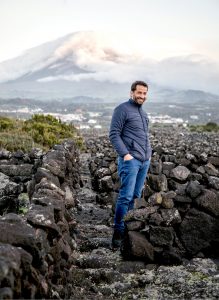 António Macanita i vingården på ön Pico, Azorerna. I bakgrunden Pico.
António Macanita i vingården på ön Pico, Azorerna. I bakgrunden Pico.
The grapes we cherish
Now after 10 years, I am proud to say that Terrantez do Pico, is one of the jewels amongst varieties of the Azores region. Today this grape is back in the vineyards with a total of 34 hectares planted. And this success led to another unique grape, the Arinto dos Açores.
Note that the latter is different from the Arinto what is grown on the mainland (Portugal). The Arinto dos Açores so pure, crisp and magnificent saline. The next one of the ancient, almost extinct ones is a red grape called Saborinho, that takes you to heaven and back. And after Isabella, the grape what saved the Azores after Phylloxera, a grape that once you taste you will never forget with its intense flavor of wild strawberries.
Later this work turned into to a scientific article about the Origin of Grape Verdelho and the origin of the grapes of the Azores Islands were we demonstrate that the most likely point of origin of this grape is the Azores.
This has turned into a project of a lifetime, Azores Wine Company. Our wine production project has been leading the recovery of this forgotten region and its unique grapes. And we are assured that this region will never again be re-colonized from grapes form other regions.
And what now, what about the future, what is a great wine
So, what is a great wine? Food, pleasure, ageing potential, culture, grapes, soil or technique? And how much of each one of them weights in the final formula.
For the consumer I would say a great wine is a wine you like, full stop.
Now for me a great wine is a wine that managed to capture what makes a region unique, it should make me travel in a glass, and should age well. I hope to show this wine at least to the next generation, to my daughters when their old enough to drink.
History gives us perspective. It shows us that we are just passing by, and most of our problems someone tried to solve already.
We can say that the collective effort to eliminate fortifications or chaptalization of wine has been won. Also, that the overall quality of wines with clean fruit is a fact, not a coincidence. There has never been so much nice wine on the planet as today. And if that is what you are looking for you can almost blindfolded pick a wine in any supermarket and it will be ok.
At the same time, there has never so many wine connoisseurs as today. A lot of consumers want more than just nice wine. And if you are one of them, and are looking for some sort of artistic expression, touch of culture, sense of place and if you want to travel to the other side of the world in a glass of wine - I challenge you to dig in the diversity and uniqueness that wine can offer.
Summary - wine in historic perspective for a glimpse of the future
I urge you to jump out of your comfort zone, drink what you like and not what others say it’s good. For sure take advice, but taste for yourself.
Secondly, as a proud Portuguese, wine producer and wine enthusiast in a country with more than 350 indigenous grape varieties, pay us a visit to discover the uniqueness of Portugal. And finally come and discover the wines we have been making in last years.
Saúde! My wishes of great 2021 full of health, love and wine, it's your choice!
REDAKTÖREN OCH VINBANKENS TACK
António Maçanita är i dag en av Portugals mest omtalade vinmakare. Förutom egna projektet Azores Wine Company, är han konsulterande vinmakare till 13 andra vinproducenter i Portugal.
Ett av Antónios mest intressanta projekt (enligt redaktören) är återuppbyggandet av vinodlingarna på Azorerna. Vinerna som produceras på denna unika plats har få, om någon, motsvarighet i världen.
Stort tack till António Macanita för hans tankar och krönika för 2021: 'Vin - en tillbakablick för att möta framtiden'.
Macanitas viner representeras i Sverige av importören Handpicked.
LÄNKAR:
Om vinerna från Azorerna
FILM på YOUTUBE, med António Macanita och om frågan 'vad är naturvin'.
TIDIGARE KRÖNIKÖRER OCH RÖSTER
Call for (more) action - by Miguel A. Torres











